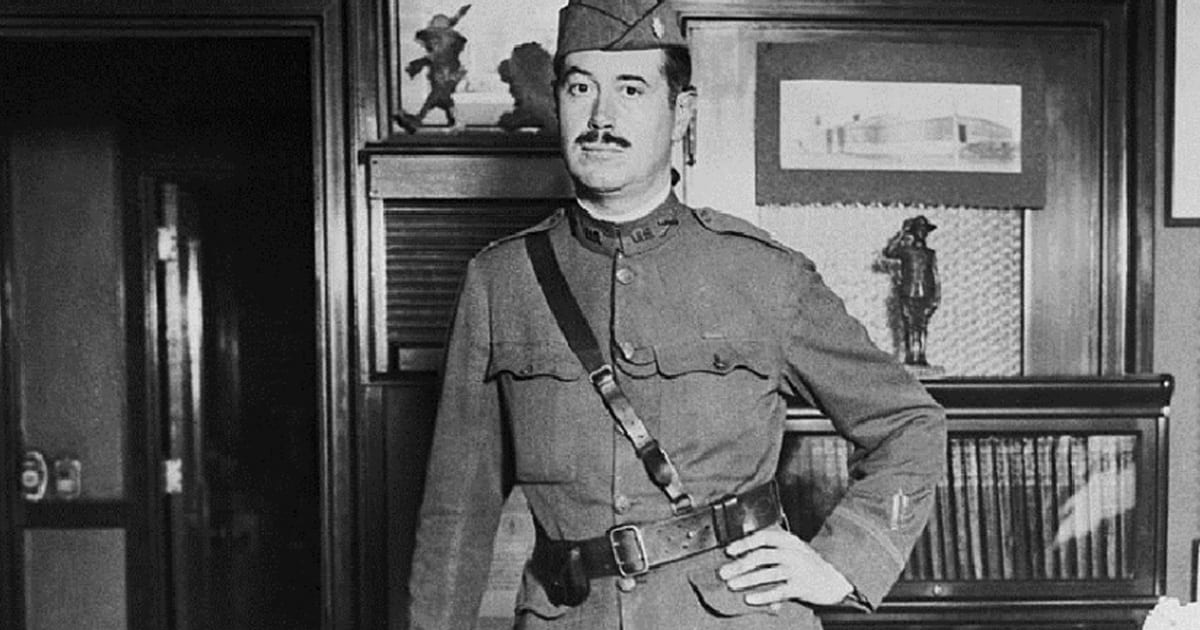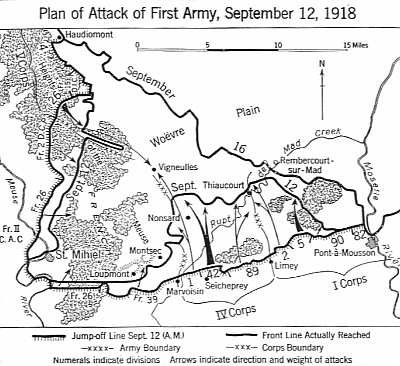
Under the War Department, the First Division of the United States military also known as ‘The Big Red One’ was founded on May 24, 1917 [1].This division although new was founded on existing divisions and would see combat throughout the United States Army involvement in World War 1 in Europe. Due to their experience with this new style of warfare would leave an impact on members that call the great lake region home in post war America.
With the entry into the war, the American military was ill-prepared for the conflict. With the lack of any experienced military members in the new style of warfare, the French and British forces offered to take the American troops into their own units and take over their training [2]. This was rejected almost immediately along with a proposal by the British to include a battalion of American infantry into each British brigade then to create American divisions into British divisions until there were enough for a full American army [2]. To lead the American Expeditionary force, General John J. Pershing was selected. Unlike the other allied generals of the time, Pershing was for taking the ‘offensive spirt’ and maneuvering [3].
Formation
The First Division during the initial years of U.S involvement, was a mixture of already established infantry regiments consisting of the 16th, 18th, 26th and 28th ts that had been trained in the United States and were stationed near the Mexican border [4]. In June 1917, the infantry regiments that would make up the division left New York for France [1]. On July 4, the 2nd battalion of the 16th infantry marched in Paris to raise the spirts of those there. During this event, the famous words from General John J. Pershing’s staff uttered the words “”Lafayette, we are here!” in reference to the French General that fought for the United States in the Revolutionary war [5]. A few days later, the First Expeditionary Division was designated the ‘First Division’ [5]. From their arrival until October of that year, the 1st were trained and placed into quiet sections of trenches by the French forces in the Sommerviller section. While in the ‘quiet section’ the 1st division suffered the first American casualties of the conflict during a night raid by Germans in the area. It became clear that the infantry needed more training in dealing with trench warfare [6].
Battle of Cantigny
In order to raise the prestige of the AEF and to prove its effectiveness to the world, Pershing decided to attack the small town of Cantigny with the closest unit available. By May 20, 1918 The 1st infantry division had been at the trenches opposing the town for a month [6]. On May 28th, the division opened the U.S. offense combined with support of its artillery detachments at 0545 and French allies close to the town [6]. The American forces were able to take the town by 0700 hours, taking 100 German prisoners and only suffering 50 casualties [6]. However, only a short time later, the Germany artillery began to attack the town combined with infantry from hidden dugouts [6]. The battle continued on for most of the day, and at 1640 the Germans artillery launched a major bombardment, followed up by an infantry counterattack [6]. During this counter attack, Major Teddy Roosevelt Jr., led the 26th infantry to counter further counterattacks. By the 29th, the battle was over at a cost of 1,400 casualties to the Americans [6]. More importantly, it showed that the Americans in Europe could fight and achieve results.

One of the famous members of the First Division was Colonel Robert R McCormick who commanded the 1st Battery, 5th Field Artillery, First Division during this battle. Before and after the war would be more famous for running The Chicago Tribune Company [7]. When he returned home from Europe, McCormick would rename his estate from ‘Red Oaks’ to ‘Cantigny’ to honor those that served with him [7] .Upon his death in 1955, the Robert R. McCormick Charitable trust was established, along with his home and grounds donated as a public space [8]. One of the features of the grounds besides the home, tank park and garden, is the museum of the 1st infantry. This museum covers the units history from world war one up into the modern era [8].
Battle of Soissons

The Battle of Soissons was the name of the counterattack of the Allied forces during the Second Battle of the Marne, the last major offense that the Germany army attempted during the conflict [9]. From July 15 to the 17th, the German army attacked the allied forces to try to get across the Marne river and push towards Paris. Thanks to American army efforts, the German right wing failed to take any land across the Marne [9]. In order to attack and force the German retreat, the allies planned on attacking the entire Marne salient. The Allied forces then selected the 1st American, 2nd American and 1st Moroccan (French) divisions to break the sensitive part of the German lines located south of Sossions [9]. At 0435 on July 18, the attack began and by the end of the offensive on July 21, the 1st division was able to advance 11 kilometers into the salient. Furthermore, the 1st was able to capture 3,500 prisoners and 68 field guns. The 1st Division during this attack lost 7,000 men with an estimated loss of 60 percent of its officer corps [9].
The Battle of St. Mihiel

The battle of the St. Mihiel salient took place from September 11-13 1918 and is the first battle of the war that the United States Army took its first offensive [10]. The attack began on September 12 at 0500 hours with a limited 4 hour bombardment of the German trenches. During the American advancement, the American forces were successful at moving up and were able to capture the salient’s southern boundary [10]. By 0600 the next day, the American forces were able to the capture the town of Vigneulles. After pushing back the German counter attack later that day, the Germans retreated from the area [10]. For some such as Corporal Carl C. Kenney of 1st Motor Supply Train, Co. F, the experience of battle was somewhat different from the other infanty men. In his diary, he explains his role throughout the battle.
September 11, 1918. Got up at 6am. Hauled rations. Raining hard today. September 12. We started another drive on the St. Mihiel front. September 13. Bosh are retreating fast, hauled wounded all night. [11]
To say the least, the Corporal had a different view of the battle compared to the regular infantry man.
Meuse-Argonne Forest Campaign
The Meuse-Argonne Forest Campaign took place in the region of France of the same name. Due to the terrain of the area being manly forest and valleys the region was an ideal defensive position (Hart, Peter). The fighting in the region was brutal event. As told by Lieutenant Maury Maverick of the 28th Infantry Regiment [2] :
We had reckoned without a German rear guard action. And no doubt they had heard us telling our men to get ready. They were soldiers who had trained 4 years at the front. They had left their lines checker boarded with machine guns, had left their men in the rear to fight to the death, and had slowly moved out the heavy masses of troops. Most of us who were young American officers knew little of actual warfare- we had daring but not the training of the old officer of the front. The Germans simply waited, and then laid a barrage of steel and fire. And the machine gunners poured it on us. Our company numbered two hundred men. Within a few minutes, about half of them were either dead or wounded.[2]
Later on in this battle Lieutenant Maury was forced to take command after his commanding officer was killed. At this point he describes the chaos that reigned.
I took command of the company. There was not a single sergeant. We literally lost each other. There were no bugles, no flags, no drums and, as far as we knew, no heroes. The great noise was like great stillness, everything seemed blotted out. We hardly knew where the Germans were. We were simply in a big black spot with streaks of screaming red and yellow, with roaring giants in the sky tearing and whirling and roaring. There is a great swishing scream, a smash-bang, and it seems to tear everything loose from you. The intensity of it simply enters your heart and brain and tears every nerve to pieces. Although so many men had been killed, there was nothing to do but keep on going. And in front were dense growths of trees and barbed wire to keep us from going further. [2]
The Meuse-Argonne campaign would continue from October 1st until November 11th [5].
The First infantry Regiment would later help to occupy Germany until the formal signing of the Treaty of Versailles [5]. The regiment would return home that following year from August to September [5]. With their service, the division would boast Medal of Honor recipients and carry campaign streamers for Montdidier-Noyon, Aisne-Marne, St. Mihiel, Meuse-Argonne, Lorraine1 1917, Lorraine 1918, and Picardy 1918 [5]. To say the least, the Big Red One was involved in nearly every major battle of the Western Front for the United States. With this experience, it would influence its members for the rest of their lives.
Primary Sources
- [4] Shinnick, William. “HOW WE SAVED EUROPE THE FIRST TIME: OUR FIRST AEF OUR FIRST AEF.” Chicago Daily Tribune 05 July 1942: 1+. Print.
- [11] “First Division Museum At Cantigny”. Firstdivisionmuseum.Org, 2016, http://www.firstdivisionmuseum.org/museum/online/toward_the_front/st_mihiel/diary/entry1.aspx.
Secondary Sources
- [1] “1st Division – World War I.” Order of Battle of the United States Land Forces in the World War. Vol. 2. U.S. ARMY CENTER OF MILITARY HISTORY, 29 July 2016. Web. 16 Oct. 2016. http://www.history.army.mil/books/wwi/ob/1-ROE-OB.htm
- [2] Hart, Peter. The Great War. 1st ed. Oxford University Press, 2013. Print.
- [3] “The Battle Of Cantigny, WWI”. 2012. Web. 17 Nov. 2016. http://www.pritzkermilitary.org/whats_on/citizen-soldier/battle-cantigny/
- [5] “History.” Society of the 1st Infantry Divison. 2016. Web. 16 Oct. 2016. https://www.1stid.org/historyindex.php.
- [6] Westwell, Ian. 1st Infantry Divison ‘Big Red One’ : Compendium, 2002. Print.
- [7] “First Division Museum At Cantigny”. Firstdivisionmuseum.Org, 2016, http://www.firstdivisionmuseum.org/research/mccormick.aspx.
- [8] “History & Mission”. Cantigny.Org, 2016, http://www.cantigny.org/about-us/history-and-mission.
- [9] “The Second Battle Of The Marne”. Worldwar1.Com, 2016, http://www.worldwar1.com/dbc/2marne.htm.
- [10] Adwar, Corey. “America Fought Its First D-Day 96 Years Ago Today, And It Was A Huge Success”. Business Insider, 2016, http://www.businessinsider.com/battle-of-st-mihiel-was-americas-first-d-day-2014-9.
